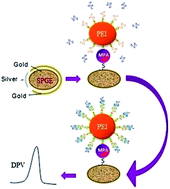Gold–mercaptopropionic acid–polyethylenimine composite based DNA sensor for early detection of rheumatic heart disease†
Abstract
The first gold–mercaptopropionic acid–polyethylenimine composite based electrochemical DNA biosensor was fabricated for the early detection of Streptococcus pyogenes infection in humans causing rheumatic heart disease (heart valve damage). No biosensor is available for the detection of rheumatic heart disease (RHD). Therefore, the mga gene based sensor was developed by the covalent immobilization of a 5′-carboxyl modified single stranded DNA probe onto the gold composite electrode. The immobilized probe was hybridized with the genomic DNA (G-DNA) of S. pyogenes from throat swabs and the electrochemical response was measured by cyclic voltammetry (CV), differential pulse voltammetry (DPV) and electrochemical impedance (EI). Covalent immobilization of the probe onto the gold composite and its hybridization with G-DNA was characterized by FTIR and SEM. The sensitivity of the sensor was 110.25 μA cm−2 ng−1 with DPV and the lower limit of detection was 10 pg per 6 μL. The sensor was validated with patient throat swab samples and results were compared with available methods. The sensor is highly specific to S. pyogenes and can prevent damage to heart valves by the early detection of the infection in only 30 min.


 Please wait while we load your content...
Please wait while we load your content...